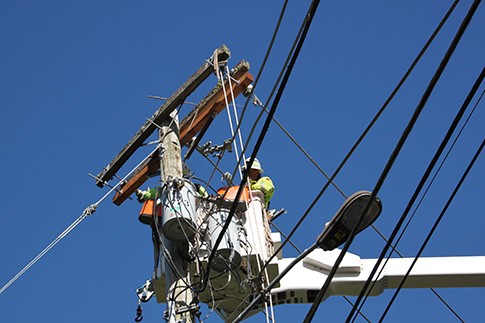Related News
Related News
-
EWEB Partners with Eugene School District 4J to Celebrate New Kennedy Middle School Emergency Water Station Site
Hundreds of attendees practiced filling up water containers at Saturday's demonstration event.
Find Out More -
Electric Projects underway in North & South Eugene
Underground lines and disaster-resilient power poles are part of EWEB’s infrastructure upgrade near Eugene’s largest natural resource area.
Find Out More -
EWEB general manager to retire in 2026
EWEB launches nationwide search for next leader to continue the progress of the last decade and ensure a smooth transition.
Find Out More -
Quartz Creek: Setting the Stage for Floodplain Restoration
The project resets the floodplain along 1.8 miles of a formerly channelized creek to improve water quality, fish habitat and natural disaster resiliency.
Find Out More -
Join the Pledge to Prepare
When you think about getting ready for an emergency, you probably have questions. You aren't alone. Preparing for emergencies can be overwhelming, which is why EWEB has put together a 12-month program to help you and your family get two weeks ready.
Find Out More -
You can’t predict the next disaster, but you can prepare
The earthquake lasted less than a minute. But now the power’s out. The tap runs dry. Cell service is spotty. Would you be ready?
Find Out More -
EWEB completes helicopter installation of salmon habitat features
EWEB adds downed trees and 2,000 tons of gravel to the Uupper McKenzie River below Tamolitch Falls to improve spawning habitat.
Find Out More -
Oregon’s New Utility Laws and How EWEB Customers Already Benefit from Fair, Transparent Rates
Oregon’s POWER Act and FAIR Energy Act target investor-owned utilities. Learn how EWEB’s local, community-owned model already meets these goals.
Find Out More -
EWEB Celebrates Operators on the 75th Anniversary of the Hayden Bridge Filtration Plant
Learn more about the Water Treatment Plant Operators who have kept the Hayden Bridge Filtration Plant running for the last 75 years.
Find Out More -
NASA partners with EWEB to assess wildfire impacts to drinking water
NASA's Earth Information Center shares a new video detailing how EWEB's Drinking Water Source Protection work is advising new research tools
Find Out More -
EWEB prepares for wildfire season with risk mitigation measures
EWEB is building a more resilient electric system to weather various types of disasters, from wildfire to winter storms.
Find Out More -
Sustainability Snapshot - Homes for Good May 2025
Our first Sustainability Snapshop highlights a project where EWEB teamed up with longtime partner, Homes for Good, to deliver ductless heat pumps to income-eligible apartment rentals.
Find Out More -
EWEB environmental specialist wins prestigious awards for publication
Article recounting EWEB’s efforts to protect the McKenzie River after Holiday Farm Fire earns national recognition
Find Out More -
Last Call for EWEB/Lane County Septic Grants
Holiday Farm Fire recovery program now eligible for businesses, residential property owners who purchased post-fire, to cover inspection costs and new construction
Find Out More -
EWEB, Lane County host open house to gather feedback for “Leaburg Transportation Alternatives Analysis”
“What is the Future of the Leaburg Dam Bridge?” open house exhibit on display at Lloyd Knox Park Visitor Pavilion through July 25
Find Out More - Show More
Grid Hardening Lowers Fire Risk, Increases Reliability
September 30, 2021

While most wildfires are started by lightning strikes or caused by human actions, utilities have a role to play in risk reduction -- and we are doing our part. And while we can't stop wildfires, we can make our electric infrastructure more resilient to better withstand fires by using new construction methods and materials and keeping our system maintenance up to date by replacing aging equipment.
EWEB employs a full menu of options for "grid hardening" strategies, including a robust vegetation management program, replacing older equipment on a regular basis, full system inspections, and in some cases, placing power lines underground.
One of the measures underway this summer and fall is the inspection and replacement of power pole crossarms. Our line technician crews have been working for the past several months to identify and replace older or deteriorating crossarms in the McKenzie River Valley service territory and on select circuits in south Eugene.
Replacing crossarms is a labor- and time-intensive process, where the crews are often working within a few feet of energized powerlines. However, this is one of the measures that could prevent EWEB facilities from becoming an ignition point for a wildfire.
During high wind events, such as the gusting, erratic winds seen during Red Flag Warnings, the failure of a crossarm could bring down energized power lines and potentially spark a fire. To help reduce that risk, crews are now finishing up the replacement of more than 100 crossarms in the McKenzie River and south Eugene areas.
"Our approach is to use multiple investment and replacement strategies to maintain reliability and increase resiliencies for all types of weather conditions the electric system must face," said Electric Operations Manager Tyler Nice.
"Most often mentioned as an improvement to mitigate fire risk is undergrounding lines, however, that option typically cannot be acted on right away, may not be feasible, or be cost prohibitive," Nice said. "Preforming inspections and turning around maintenance work quickly for high-risk areas and ailing equipment is not only a quicker option, but is financially responsible, and will provide reliable service for years to come."
Another risk reduction strategy is to replace wooden power poles with metal poles in areas that are at higher risk for wildfire.
This past spring, EWEB finished a project that used ductile iron poles to replace wooden poles in a section of its upper McKenzie River transmission line. The ductile iron poles are much more resistant to fire than wood. The project at Deer Creek is the first time EWEB has installed ductile iron power poles.
"Not only will the ductile iron poles prove more resilient in surviving a wildfire, but we actually improved habitat by placing the new poles away from Deer Creek, which is the largest tributary to the McKenzie River," Nice said.
Along with grid-hardening activities, we also conduct routine system maintenance to keep electric infrastructure functioning safely and properly throughout the year. The reliability work includes proactively pruning trees and removing brush to help keep our equipment clear of contact, and for access if an outage repair should be needed. In addition to the regular vegetation management, tree-trimming crews spend extra time pruning in areas at higher risk of wildfire.
Crews regularly inspect electric lines, poles, components and other equipment, replacing worn or older parts as needed. This work not only helps keep the system operating during snow, ice and windstorms, but reduces the likelihood of some types of equipment failure that may causing sparking that could ignite a wildfire.

